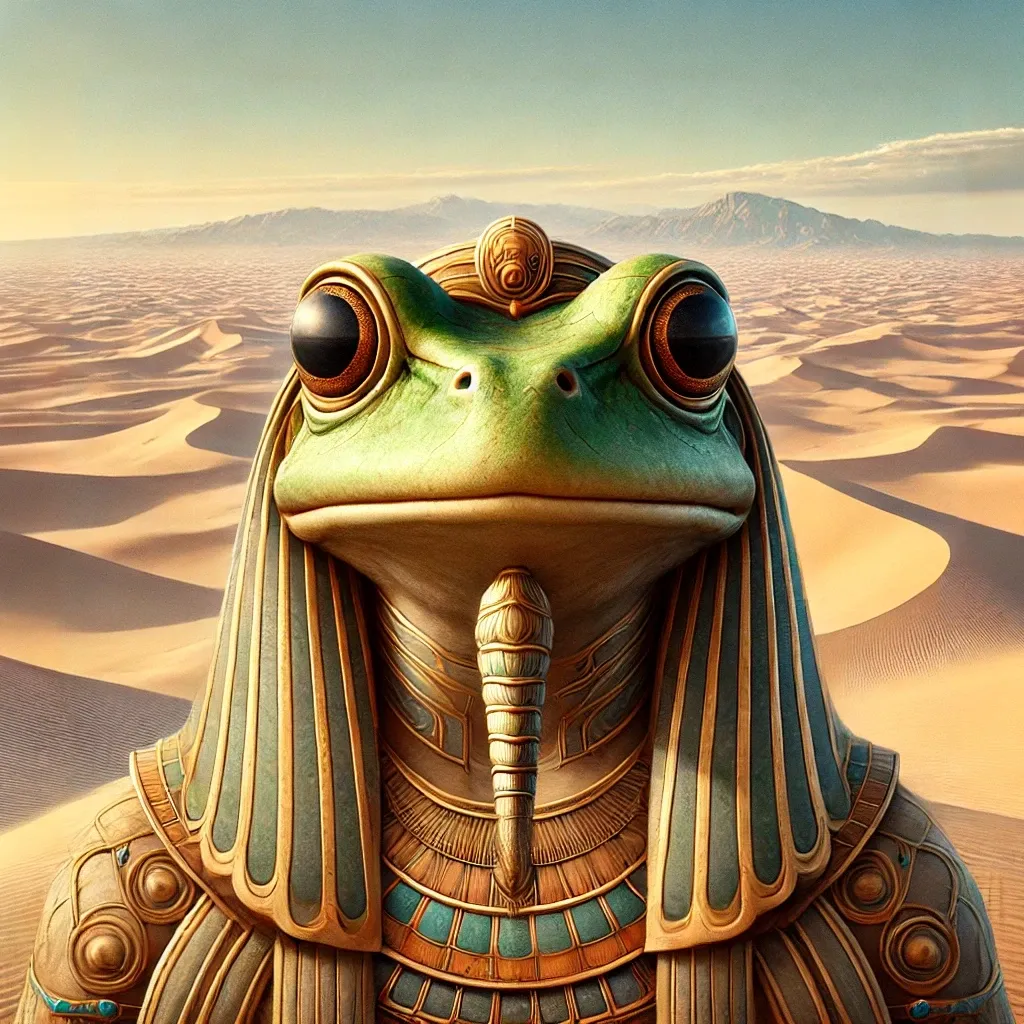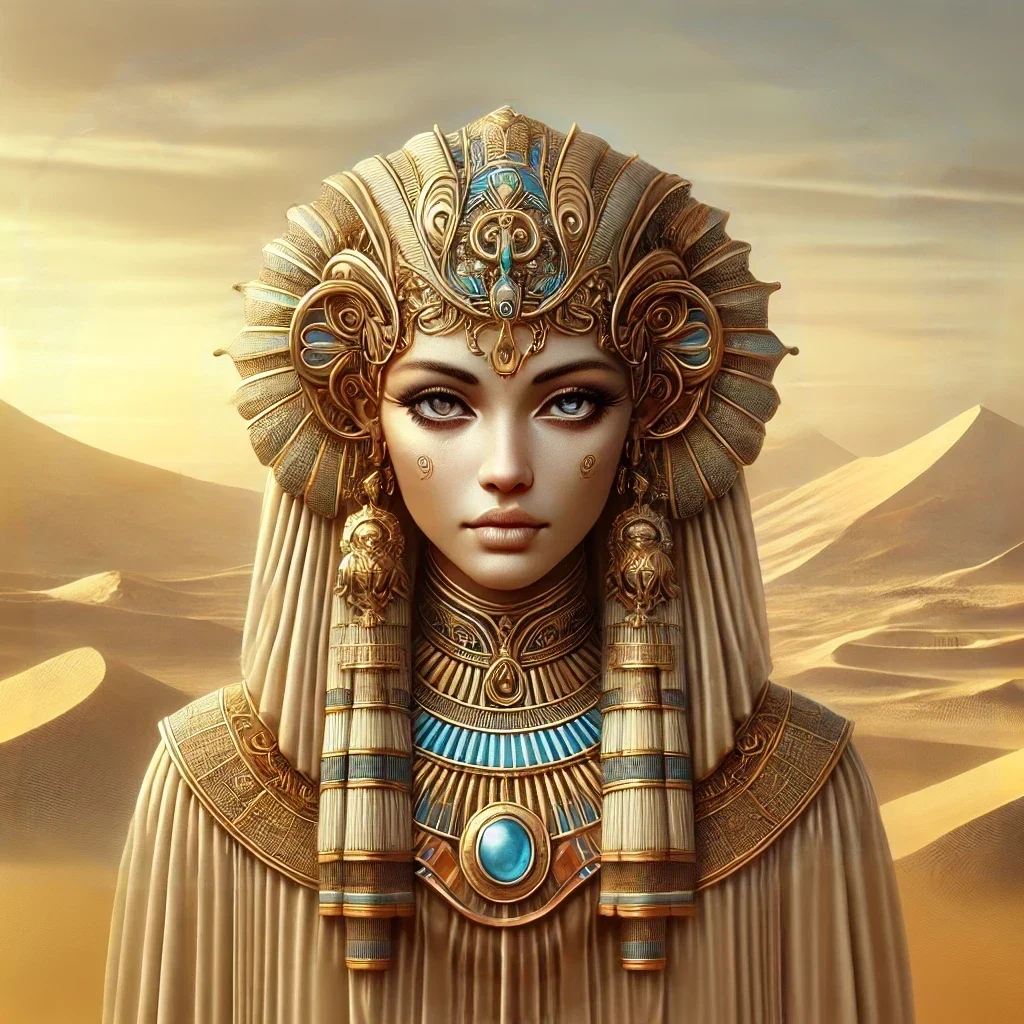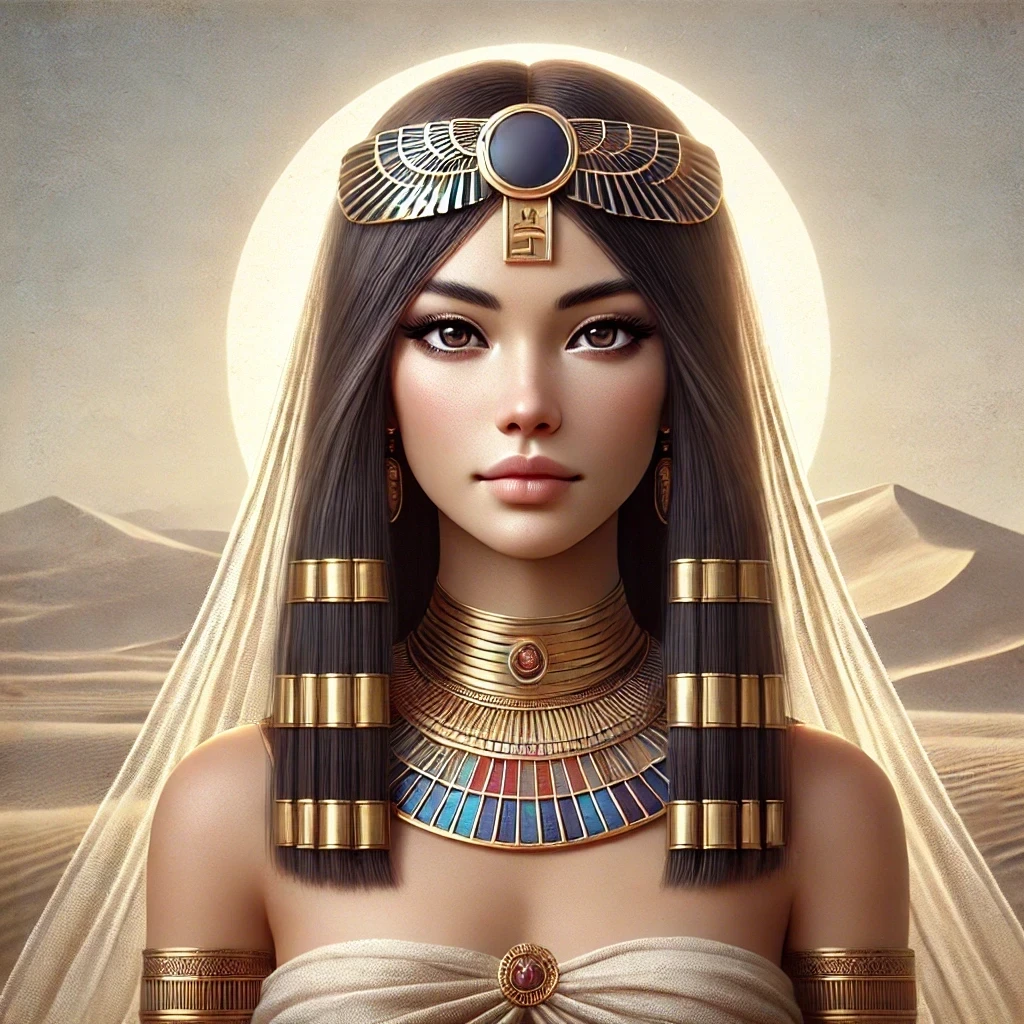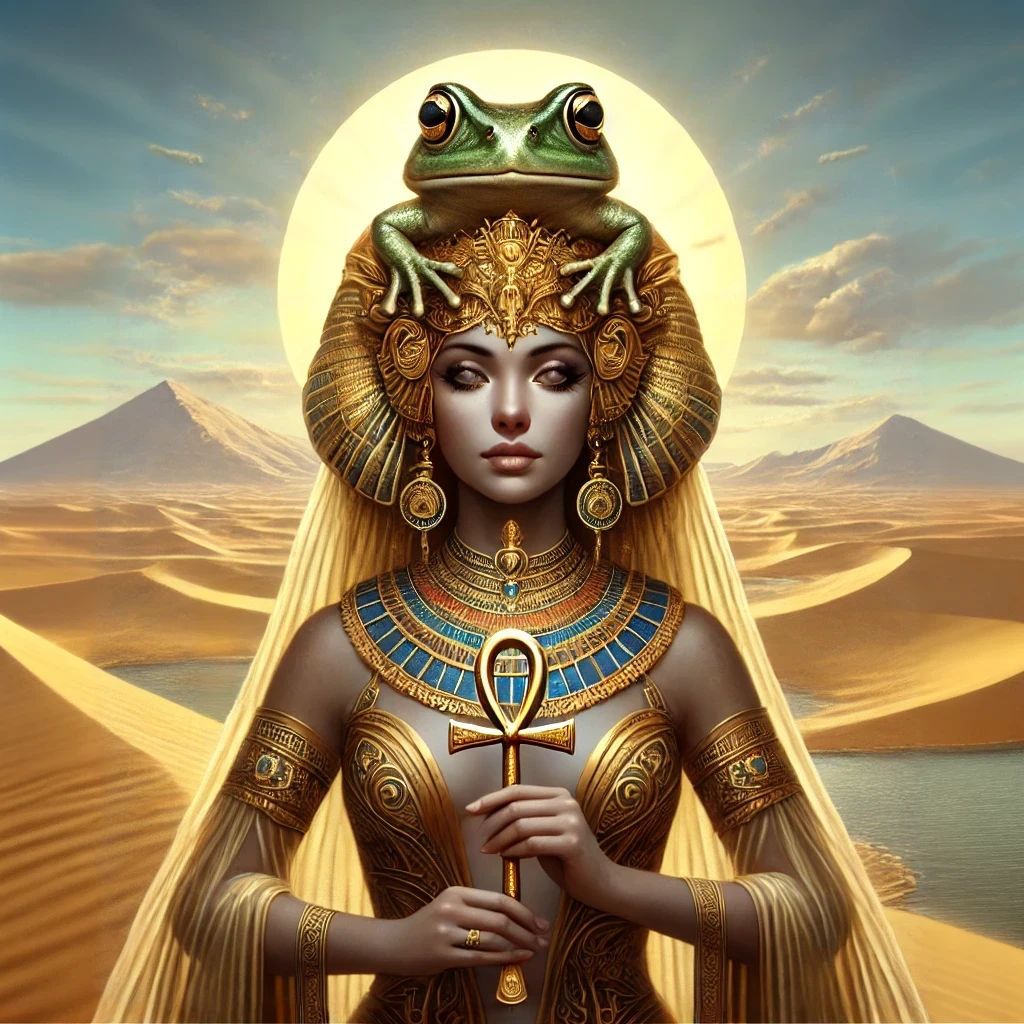The deity known as Heh was a primeval figure in ancient Egyptian religion, revered as the personification of eternity and boundlessness. Linguistically, the name is derived from an ancient word conveying the concept of endlessness, while epithets such as “Lord of Infinity” and “Keeper of Unceasing Time” further highlight the god’s enduring nature. Scholars connect these titles to the Egyptian fascination with cycles and vast temporal expanses. Woven into various creation narratives, this entity served as a symbol of the limitless potential before the cosmos took shape. Far from a marginal figure, the Boundless One was integral to the mythological tapestry, promising perpetuity in a civilization deeply concerned with the afterlife and the eternal journey of the soul. Representing the infinite horizon of existence, this deity stood as a powerful allegory for life without end and a testament to the enduring creativity of ancient Egypt’s theological imagination.
Origins
Earliest Mentions
According to surviving inscriptions and mythological texts, the earliest references to this primeval entity can be traced back to the Old and Middle Kingdom periods of ancient Egypt. The oldest hints occur in funerary writings where cosmic waters and the notion of formless expanses are frequently invoked. Though these texts do not always name Heh explicitly, the allusion to unending waters and infinite time suggests early conceptions of a deity who embodied immeasurable duration. Hieroglyphic carvings on sarcophagi and in temple reliefs offer glimpses into how the Egyptians perceived the interconnectedness of space, time, and divinity. Over time, details about the cosmic figure crystallized in sources like the Pyramid Texts and Coffin Texts, which aligned this infinite aspect with other members of the Hermopolitan Ogdoad—a group of eight primordial deities.
The position of the male form of this cosmic principle in the Hermopolitan cosmogony indicates a foundational role in the creation process. In these texts, the ancient Egyptians describe a watery void from which the ordered universe emerged. Positioned at this interstitial moment between nothingness and being, Heh symbolized the limitless reservoir of possibility.
Cultural Context
In the broader cultural matrix of ancient Egypt, deities representing abstract concepts were common. The civilization maintained a rich pantheon where natural forces, social principles, and metaphysical ideas all found expression in godly forms. Among them, this particular personification of eternity underscored the Egyptian perception of time as cyclical rather than strictly linear. Life, death, and rebirth were seen as continuous processes, and the concept of endlessness was intimately connected with the cyclical renewal that Egyptians hoped to attain in the afterlife.
By the New Kingdom, local cult centers and temples across the Nile delta incorporated Heh into broader rituals, reinforcing the notion that every dawn signified renewed cosmic stability. Royal inscriptions often emphasized the king’s role in perpetuating order, placing him in alignment with the powers of infinity. This incorporation made the everlasting principle a significant corner of pharaonic ideology, coloring the way Egyptians viewed their kings, their land, and their place in the cosmos.
Appearance
Iconography in Ancient Art
Visual depictions of Heh often showcased symbols of boundlessness and longevity. In many temple reliefs and funerary papyri, the deity is represented in anthropomorphic form, seated or kneeling, sometimes holding notched palm ribs that signify the tallying of years—an iconographic marker for long duration. In certain forms, the figure could also appear with the head of a frog, a motif associated with the “fertile” and “amorphous” nature of creation. The frog element was especially common within the Ogdoad framework, where four male deities took on frog heads, and four female counterparts were serpentine, encapsulating dual facets of generative chaos.
The arms and hands of the cosmic personification are frequently shown extending or lifting objects like the sun disk or the shen ring, a symbol for divine protection. These images projected the idea of sustaining the solar cycle, reinforcing the association with time’s continuous renewal. Engraved or painted scenes within tombs and temples often underscore the Heh’s direct participation in the cosmos’s ongoing refreshment.
Symbolic Imagery
A key emblem intertwined with this deity’s portrayal is the palm frond. In hieroglyphic representation, palm fronds were customarily used to count extensive numbers, as each notch on the rib stood for a hundred thousand or a million years—a testament to the Egyptians’ desire to quantify vast expanses of time. Consequently, Heh’s iconography seamlessly merged math and myth, linking the ritualistic importance of numbers with cosmic infinity.
Additionally, the being sometimes appeared supporting other symbols of duration, like the ankh or the was-scepter, reinforcing his connection to both life and power. The small pot or jar sometimes shown in scenes with this figure might reflect the abundance and sustenance believed to flow from the infinite realm. Whether depicted on a temple wall or inscribed on amulets, the imagery served as a perpetual reminder of the unbroken cycles that underpinned Egyptian cosmology.
Abilities
Protective Powers
Within the ancient worldview, this divine force did more than merely represent endless time. Protection was a key facet: by maintaining the rhythm of existence, Heh warded off chaos. In a tradition where cosmic disorder threatened every living thing, sustaining the endless horizon of time was tantamount to guarding the universe itself. The continuum of days and nights, the rise and set of the sun, and the birth and death of living creatures all hinged upon the ceaseless flow granted by this infinite principle.
Protective spells in funerary texts would sometimes allude to the deity’s guardianship over the deceased, ensuring safe passage through the underworld. These spells evoked the notion that the spirit’s journey toward rebirth in the afterlife paralleled the cyclical renewal in nature, a cosmic maintenance function anchored in a divine caretaker of perpetuity.
Role in Creation
As part of the Hermopolitan Ogdoad, Heh symbolized one of four male-female pairs, each pair representing fundamental aspects of the primordial waters: darkness, hiddenness, formlessness, and endlessness. According to Hermopolitan tradition, the eight primeval figures stirred the cosmic waters, catalyzing creation by bringing forth the mound upon which the sun god would eventually appear. This generative process underscored a worldview where potential existed first in an undifferentiated state, requiring divine forces to usher in a tangible universe.
In this framework, Heh’s primary role revolved around furnishing infinite space and time, the backdrop against which all other acts of creation unfolded. Without infinite possibility, no subsequent deities, creatures, or structures could arise. Thus, the figure was perceived as a silent yet essential pillar of existence, facilitating the birth of deities such as Ra (the solar king) and, by extension, all living entities.
Domain
Concept of Infinity
The core domain of Heh’s ancient powers lay in the concept of infinity—both spatial and temporal. In Egyptian cosmology, time was not purely linear but more akin to repeating cycles that renewed order. The intangible notion of perpetual expansion, therefore, was personified by a male and female aspect working in tandem, reflecting the balance essential to the Egyptian universe. The continuous multiplication of years was not merely a poetic idea; it had practical implications in rituals meant to sustain the monarchy and the cosmos.
These beliefs were rooted in an understanding of cycles, from the daily journey of the sun god across the sky to the annual flooding of the Nile. The boundless deity acted as an anchor, ensuring these cycles remained stable across vast epochs. From festival calendars to astronomical charts, infinite time and space were integrated into every facet of Egyptian spiritual life.
Cosmic Boundaries
Although the domain of this force was infinite by definition, ancient Egyptians conceived of boundaries to demarcate the known world from the chaotic expanse. Heh thus functioned as a threshold guardian, occupying the liminal space between the ordered cosmos and the unformed beyond. Temples and ritual spaces often included symbolic motifs of the primordial waters, echoing the notion of an ever-present boundary that circled the earth.
This boundary role was significant because it pointed to the delicate balance between a stable world and the looming potential for disarray. One of Heh’s most vital functions was to maintain that boundary and keep chaos at bay. The cyclical nature of flooding, for instance, could be bountiful or destructive. By attributing control of these extremes to a personification of eternity, worshipers found reassurance in the deity’s capacity to restore order, no matter how tumultuous the natural processes might appear.
Myths
In Creation Narratives
Among the Hermopolitan creation accounts, Heh was central yet often overshadowed by more prominent gods like Thoth and Ra. The eight primordial beings, including the male aspect of endlessness, inhabited the cosmic waters before the emergence of the primeval mound. Myths describe their stirring, leading to the eventual birth of the sun god who rose from a lotus or an egg, depending on the version. This act transitioned the universe from murky potential to a structured reality.
Though not the principal protagonist in these myths, the endless figure played a quiet yet decisive role by providing the very substrate of indefinite time in which creation could unfold. By the time the newly formed sun had ascended, cosmic structure was set, with the infinite one continuing to sustain the emergent framework. The cyclical sunrise each day was a re-enactment of that first dawning, reaffirming this original covenant of continuity.
Interactions with Other Deities
Narratives highlight alliances formed with several members of the pantheon. As part of the Hermopolitan group, Heh cooperated with figures representing darkness, hiddenness, and watery chaos. Although direct conflicts involving this personification of infinity are rare in surviving texts, the deity’s subtle interplay with forces of cosmic disturbance underscores a precarious equilibrium.
More explicit references come through mention of Hauhet, the feminine counterpart of the male endlessness. Together, they bridged the gap between concept and manifestation. In the broader pantheon, the infinite principle bolstered the reign of solar deities, reinforcing the daily cycle as the universe’s heartbeat. This synergy between cosmic continuity and solar authority manifested in religious festivals, particularly those celebrating the cyclical rebirth of the sun.
Symbolism
Objects and Animals
Among the most striking symbols linked to this power is the notched palm rib, a quintessential representation of million-fold years. Egyptian artisans depicted the cosmic figure clutching these ribs in an almost protective manner, underscoring the notion that time—and by extension, life—was sheltered by a guardian. Frogs were also associated with fertility and transformation, and so the deity’s occasional frog-headed depiction enriched the image of a boundary-dissolving presence that straddled creation and chaos.
Another object frequently seen in temple art is the shen ring, an oval loop that encloses space and stands for eternal protection. When Heh is shown lifting or supporting a shen ring, it demonstrates the notion that boundlessness can be harnessed for cosmic safeguarding. In this sense, the ring signified both defense and perpetuity, both concepts tethered to the entity.
Plants and Minerals
Palm trees, lotus flowers, and other fertile symbols occasionally appear alongside the infinite one in temple reliefs and paintings. The lotus, which emerges from water to bloom in sunlight, was a powerful emblem of resurrection and renewal. By including it next to depictions of the cosmic deity, artists emphasized the perpetual cycle connecting daybreak to the primordial waters.
In certain amuletic contexts, minerals like lapis lazuli and turquoise—stones believed to hold divine essence—were crafted into protective figures or ornamentation referencing Heh’s role. These materials, prized for their enduring color and hardness, reinforced the sense of something unchanging and eternal, paralleling the ideas of infinite time and space.
Worship
Temples and Shrines
Although not as prominent in monumental temple complexes as gods such as Amun or Ra, Heh did feature in local shrines and within the decorative programs of major cult centers. In Hermopolis, where the Ogdoad tradition held sway, smaller chapels were dedicated to the primeval eight, including the male aspect of eternity. These sites often contained pools representing the primordial waters, mirroring the divine space the Ogdoad inhabited.
Patrons who visited these shrines might perform offerings of bread, beer, and incense, seeking the deity’s favor for personal longevity or for the eternal prosperity of their lineage. Walls and columns were occasionally adorned with reliefs of the cosmic force holding palm ribs, reminding worshipers of the cyclical time frames crucial to spiritual devotion.
Rituals and Festivals
Seasonal festivals tied to the cycle of the Nile’s inundation provided opportunities to venerate endlessness. Water was the essential gift of the river, guaranteeing Egypt’s agricultural bounty, and so it formed a natural connection to the primordial watery chaos. Priests, acting as intermediaries, would evoke the Heh’s power to ensure the inundation arrived at the proper measure—enough to fertilize fields without destructive flooding. Ceremonies involving libations, sacred music, and recitations of hymns paid homage to this caretaker of cosmic cycles.
Major temple rituals often showcased the synergy between the infinite principle and more prominent solar gods. During dawn ceremonies, temple gates opened to greet the rising sun, symbolically reenacting the first creation moment. The deity’s presence was invoked to re-establish the bond between the temporal and the eternal, ensuring continuity for the land and its people.
Evolution of Veneration
Over the centuries, religious emphasis shifted as dynasties rose and fell. Yet the significance of Heh did not disappear. Rather, it became interwoven into the theology of more dominant gods and goddesses. Under the influence of Theban religious currents, priests might incorporate references to boundlessness within the worship of Amun, Mut, and Khonsu, merging older Hermopolitan ideas with newer theological developments.
In the Late Period, the deity’s attributes sometimes blurred with those of other protective and sustaining figures. While direct cults dedicated to the power of infinity diminished in visibility, references persisted in funerary stelas, amulets, and even in the Hellenistic era when Greco-Roman rulers integrated Egyptian symbols into their political iconography. Through these adaptations, the ancient concept of unending time and space maintained relevance, testifying to the durability of such abstract deities in Egypt’s religious imagination.
Associations
Allies Among the Pantheon
In Egyptian cosmology, alliances were forged more around complementary functions than simple friendship. As a member of the Ogdoad, Heh cooperated with deities governing darkness, hiddenness, and watery chaos. The synergy among these four pairs was pivotal for the cosmic stirring that preceded creation. This collective role made them co-custodians of the primordial waters, ensuring that the universe’s birth was under the aegis of stable, if mysterious, deities.
Later theological developments saw the infinite principle integrated into relationships with other major gods, particularly sun deities like Ra and Atum. By collaborating with them, the cosmic power helped facilitate daily rebirth, thus conferring the essential gift of cyclical endurance.
Rivals and Ambiguous Ties
Few records suggest direct enmities for a deity associated with universal continuity. However, certain texts imply a delicate tension between infinite possibility and cosmic order. Seth, sometimes cast as a chaotic force, might indirectly clash with any entity maintaining equilibrium, but references to such struggles are sparse. In many ways, the Heh functioned above conflicts that typically involved more anthropomorphic deities, focusing instead on the sustenance of universal cycles.
On occasion, parallels are drawn between the notion of boundless potential and the Apophis serpent, the embodiment of unending chaos that threatened the sun each night. While Apophis was a purely malignant force, the divine principle of eternity occupied a more balanced role, preserving cosmic cycles and giving shape to potential rather than destroying it. This nuanced positioning helped the deity remain largely free from direct confrontations that mark mythic narratives of conflict.
Iconic Partnerships
The relationship with the deity’s female counterpart stands out as one of the most iconic within the pantheon. As complementary halves of an endless principle, the pair represented the dualism inherent in Egyptian belief: male and female, hidden and manifest, eternal and cyclical. While later myths frequently highlighted partnerships such as Isis and Osiris, or Amun and Mut, the synergy between these primeval figures laid the cornerstone for the entire Hermopolitan creation perspective.
Due to the Heh’s fundamental association with the concept of time, partnerships with solar deities were also crucial. Hymns discovered in funerary papyri sometimes describe the entity holding or propping up the solar barque, ensuring its perpetual journey across the heavens. Such depictions underscored the essential function of timelessness in supporting creation’s daily renewal.
Legacy
Political Transformations
Over the course of Egyptian history, numerous shifts in power occurred, from the rise of the Middle Kingdom to the imperial expansions of the New Kingdom, and eventually the periods of foreign rule under the Persians, Greeks, and Romans. These changes influenced the pantheon’s hierarchy. Rulers like Akhenaten introduced radical theological reforms by focusing worship on the Aten, a solar disk. In such contexts, emphasis on infinite time was subsumed into a more direct solar theology, causing the distinct veneration of the ancient principle to fade into the background.
Despite fluctuations, references to Heh appear in inscriptions that celebrate the king as a preserver of maat (cosmic order). Even when new gods and religious practices emerged, the undercurrent of continuity, symbolized by the primeval keeper of eternity, persisted, albeit more subtly than in earlier eras.
Religious Shifts
Religious beliefs in ancient Egypt were never static; they evolved in response to changing political realities, foreign influences, and internal theological reinterpretations. During the Hellenistic period, the fusion of Greek and Egyptian traditions produced deities such as Serapis, blending attributes from multiple pantheons. Abstract concepts like infinite time were incorporated into the philosophical and mystical debates of the era, especially among Neoplatonists. While the classical world recognized Egyptian theology for its antiquity and esoteric depth, the explicit cult of the infinite one did not remain as a separate entity.
Nevertheless, echoes of Heh lingered in late priestly texts, reflecting an understanding that cosmic cycles and unending life were fundamental truths. Eventually, the advent of Christianity and later Islam in Egypt overshadowed traditional religious structures. Yet even within these new frameworks, vestiges of cyclical renewal—particularly in festivals and popular customs—may be traced to the earlier reverence for perpetual continuity.
Cultural Resonance
In modern times, the Heh is less immediately recognizable than that of more famous gods like Anubis or Horus, yet his conceptual importance resonates among scholars of religion and history. Museums around the world display artifacts, including temple reliefs and funerary papyri, that depict this figure holding the palm frond of endless years, captivating visitors with the Egyptians’ profound meditations on time.
Egyptologists and theologians continue to explore the significance of the Hermopolitan Ogdoad, analyzing how the interplay of these primordial powers shaped the Egyptian worldview. Heh stands as a testament to the civilization’s grand vision—a vision that regarded the universe as a complex tapestry of cycles, each strand woven by divine forces who transcended human mortality. In reflecting on this ancient cosmic architect, one is reminded of the timeless human fascination with what lies beyond the finite, and how each culture strives to grasp the infinite that frames our existence.
Trivia
- Numerical Associations: Heh’s name in hieroglyphs includes a tadpole symbol, representing “millions,” emphasizing his link to infinity and vast numbers.
- Dual Role in Creation: As a member of the Ogdoad, Ḥeḥ’s duality with Hauhet symbolized both infinite time and infinite space.
- Amulet Popularity: Miniature depictions of the deity were commonly used as amulets, signifying protection and longevity.
- Symbol in Astronomy: Ancient Egyptians linked his endless time to the eternal cycles observed in the heavens, especially the predictable movements of celestial bodies.
- Rare Depictions in Temples: Unlike major gods, Heh’s imagery is sparse, appearing primarily in contexts emphasizing eternity rather than active worship.
- Royal Longevity Symbol: Pharaohs used phrases like “millions of years” in inscriptions, tying their reign to Heh’s eternal nature.
- Frog Symbolism: Frogs, associated with fertility and rebirth, connected the deity to themes of renewal and the Nile’s life-giving floods.
- Female Counterpart: Heh had a female counterpart in the Ogdoad, representing the duality of male and female forces in primordial chaos.
- Palm Rib as a Calendar: The notched palm ribs he held were used as calendars, with each notch marking a year, linking him to timekeeping.
- Role in the Book of the Dead: He appears in the Book of the Dead, aiding the deceased’s resurrection and eternal journey through the underworld.
- Mathematical Infinity: Heh’s concept of infinity may have influenced early Egyptian mathematics, particularly in architecture and astronomy.



